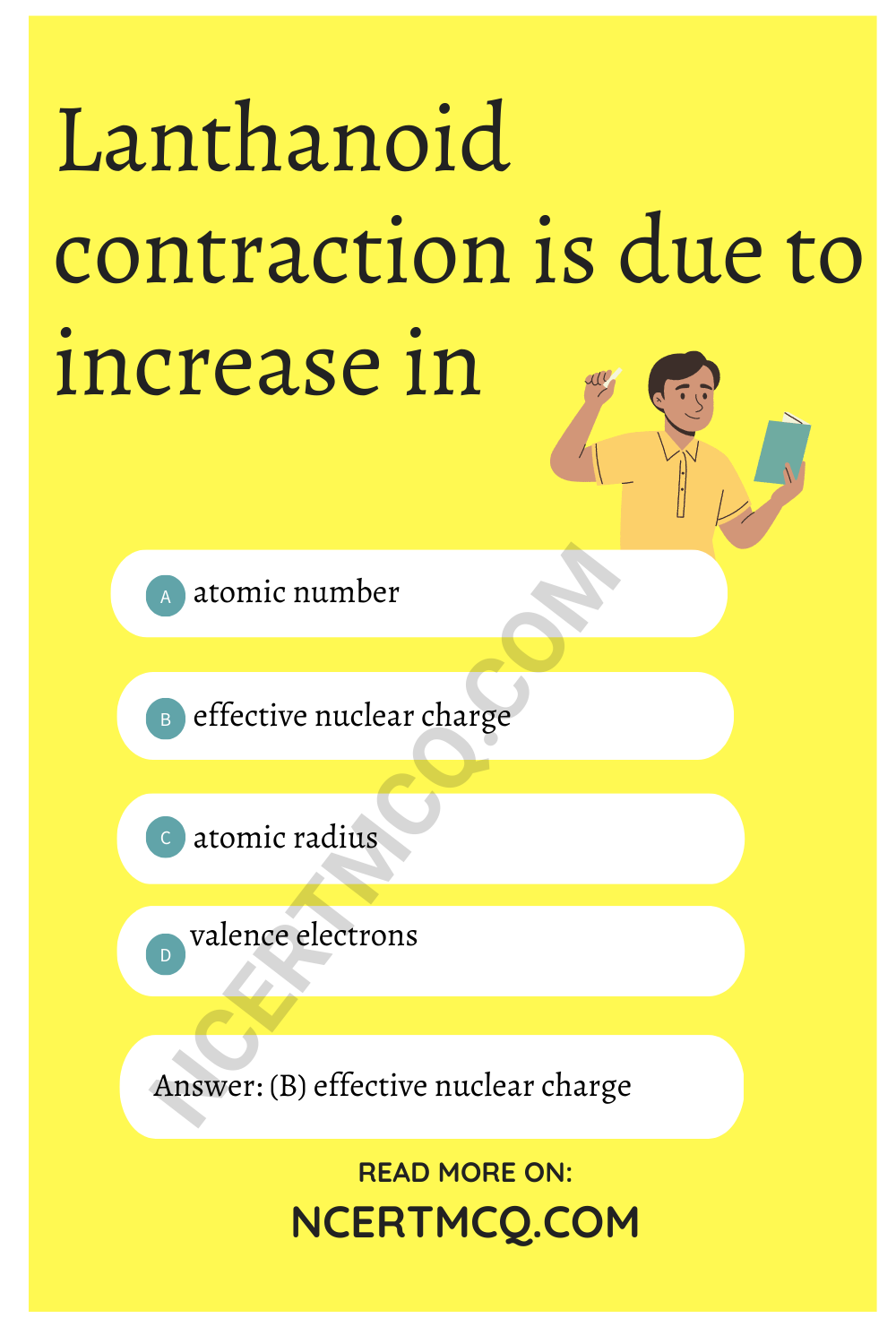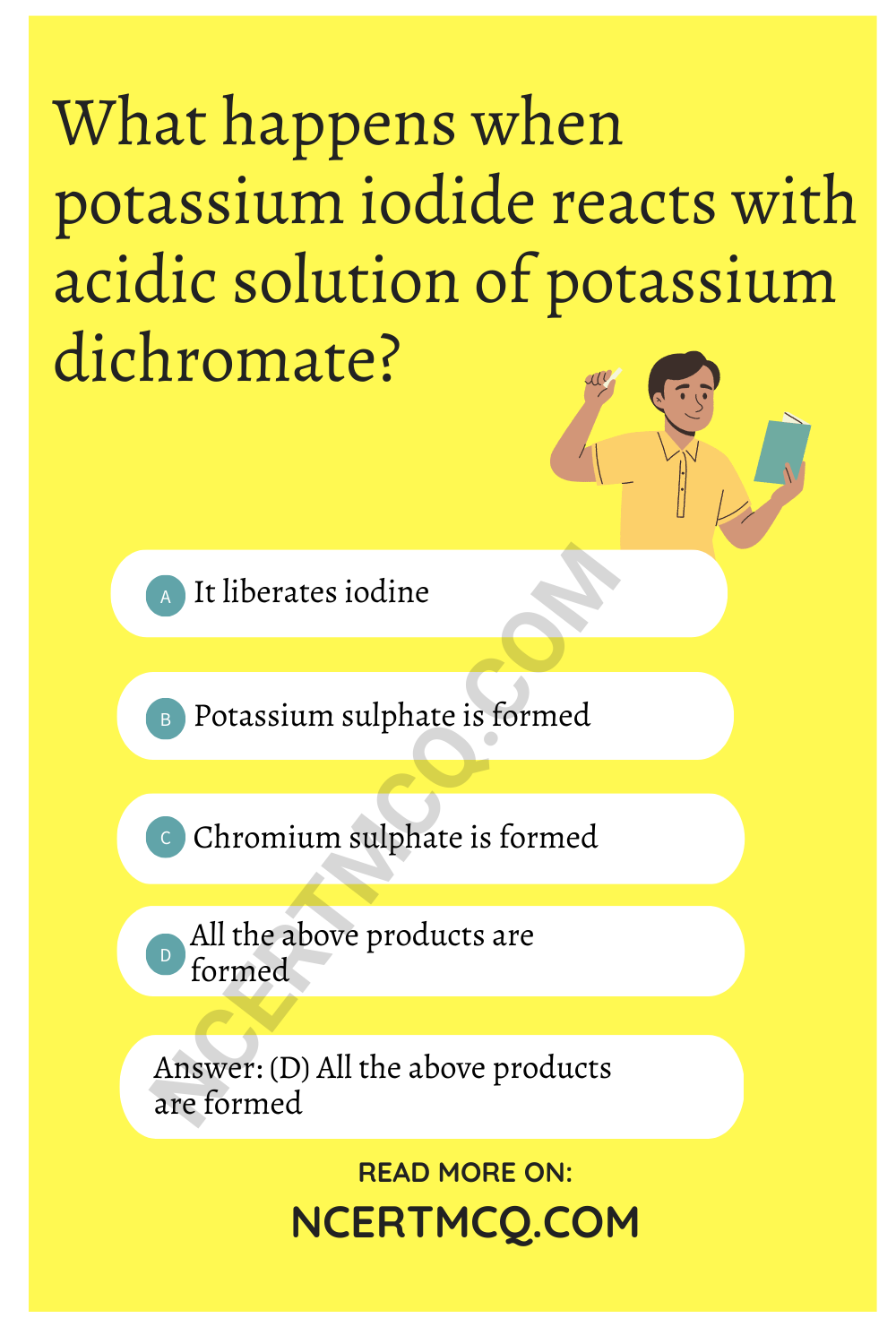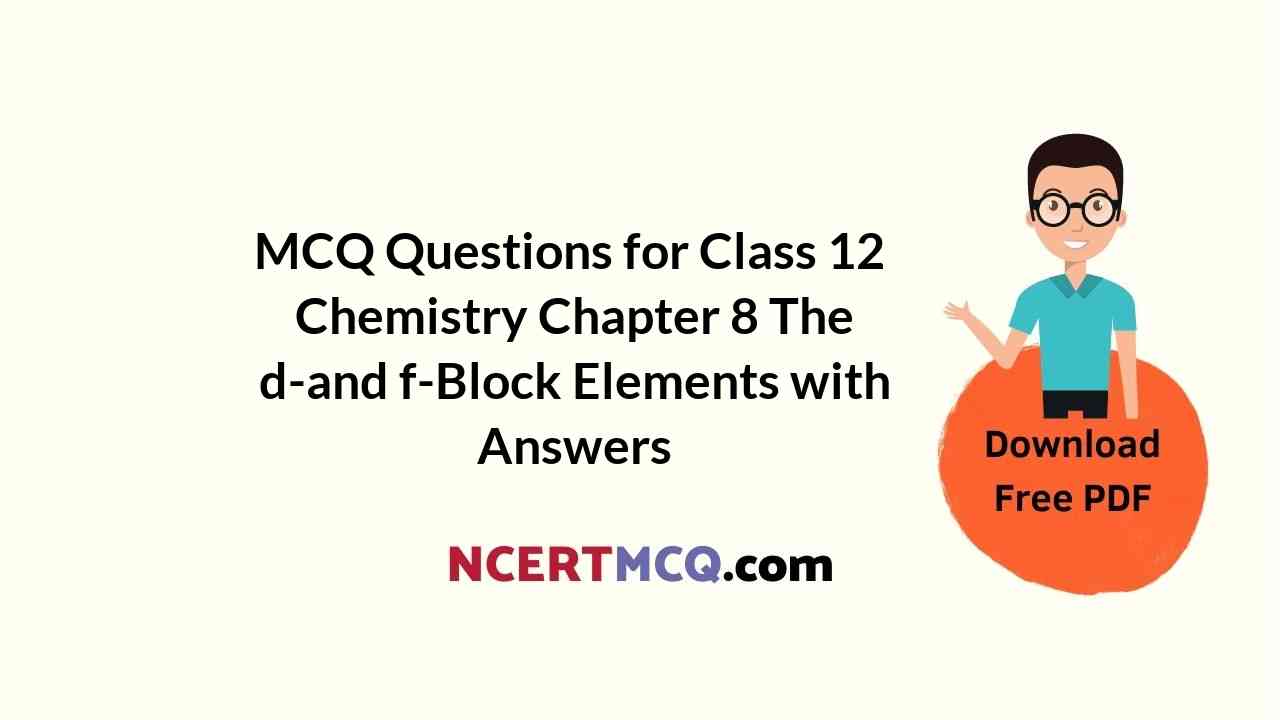Check the below NCERT MCQ Questions for Class 12 Chemistry Chapter 8 The d-and f-Block Elements with Answers Pdf free download. MCQ Questions for Class 12 Chemistry with Answers were prepared based on the latest exam pattern. We have provided The d-and f-Block Elements Class 12 Chemistry MCQs Questions with Answers to help students understand the concept very well.
Class 12 Chemistry Chapter 8 MCQ With Answers
Chemistry Class 12 Chapter 8 MCQs On The d-and f-Block Elements
D And F Block Elements Class 12 MCQ Question 1.
Oxidation number of gold metal is
(a) +1
(b) 0
(c) -1
(d) all of these
Answer
Answer: (a) +1
MCQ On D And F Block Elements Question 2.
Shape of d-orbital is
(a) spherical
(b) dumb bell
(c) double dumb bell
(d) none of these
Answer
Answer: (c) double dumb bell
D And F Block Elements MCQ Question 3.
Electronic configuration of alkaline earth element is
(a) ns2
(b) ns1
(c) np6
(d) ns0
Answer
Answer: (a) ns2
D And F Block Elements MCQ Pdf Question 4.
Lanthanoid contraction is due to increase in
(a) atomic number
(b) effective nuclear charge
(c) atomic radius
(d) valence electrons
Answer
Answer: (b) effective nuclear charge

D And F Block Elements MCQ Pdf Download Question 5.
Which one of the following is called green vitriol?
(a) FeSO4 7H2O
(b) CuSO4 5H2O
(c) CaSO4 2H2O
(d) None of these
Answer
Answer: (a) FeSO4 7H2O
D Block Elements MCQ Questions Question 6.
Which block of elements are known as transition elements?
(a) p-block
(b) s-block
(c) d-block
(d) f-block
Answer
Answer: (c) d-block
D-Block Elements MCQs With Answers Question 7.
Most abundant element in earth’s crust is
(a) Si
(b) Al
(c) Zn
(d) Fe
Answer
Answer: (a) Si
MCQ Of D And F Block Elements Question 8.
Which one of the following is diamagnetic ion?
(a) Co2+
(b) Ni2+
(c) Cu2+
(d) Zn2+
Answer
Answer: (d) Zn2+
MCQ On F Block Elements Question 9.
Which of the following is not an element of first transition series?
(a) Iron
(b) Chromium
(c) Magnesium
(d) Nickel
Answer
Answer: (c) Magnesium
MCQ On D Block Elements Question 10.
The correct order of E\(_{0}^{M^{2+}/M}\) values with negative sign for the four successive elements Cr, Mn, Fe and Co is
(a) Fe > Mn > Cr > Co
(b) Cr > Mn > Fe > Co
(c) Mn > Cr > Fe > Co
(d) Cr > Fe > Mn > Co
Answer
Answer: (c) Mn > Cr > Fe > Co
MCQs On D And F Block Elements Question 11.
The number of unpaired electrons in gaseous species of Mn3+, Cl3+ and V3+ respectively are and the most stable species is
(a) 4, 3 and 2; V3+
(b) 3, 3 and 2; Cr3+
(c) 4, 3 and 2; Cr3+
(d) 3, 3 and 3; Mn3+
Answer
Answer: (c) 4, 3 and 2; Cr3+
D Block MCQ Class 12 Question 12.
Fe3+ ion is more stable than Fe2+ ion because
(a) more the charge on the atom, more is its stability
(b) configuration of Fe2+ is 3d5 while Fe3+ is 3d5
(c) Fe2+ has a larger size than Fe3+
(d) Fe3+ ions are coloured hence more stable
Answer
Answer: (b) configuration of Fe2+ is 3d5 while Fe3+ is 3d5
D Block Elements MCQ Question 13.
Colour of transition metal ions are due to absorption of some wavelength. This results in
(a) d-s transition
(b) s-s transition
(c) s-t/transition
(d) d-d transition
Answer
Answer: (d) d-d transition
MCQs On D Block Elements Question 14.
Which group contains coloured ions out of the following?
1. Cu–. 2. Ti4- 3. Co2+ 4. Fe2-
(a) 1, 2, 3, 4
(b) 3, 4
(c) 2, 3
(4) 1, 2
Answer
Answer: (b) 3, 4
D And F Block Elements MCQs With Answers Question 15.
The melting points of Cu, Ag and Au follow the order
(a) Cu > Ag > Au
(b) Cu >Au > Ag
(c) Au > Ag > Cu
(d) Ag > Au > Cu
Answer
Answer: (b) Cu >Au > Ag
Question 16.
In which of the following pairs of ions, the lower oxidation state in aqueous solution is more stable than the other?
(a) Ti+, Ti3+
(b)Cu+, Cu3+
(c) Cr2+, Cr3+
(d) V2+, VO2+ (V4)
Answer
Answer: (a) Ti+, Ti3+
Question 17.
Which of the following pairs of ions have the same electronic configuration?
(a) Cu2+, Cr2+
(b) Fe3+, Mn2+
(c) Co3+, Ni3+
(d) Sc3+, Cr3+
Answer
Answer: (b) Fe3+, Mn2+
Question 18.
The melting point of copper is higher than that of zinc because
(a) copper has a bcc structure
(b) the atomic volume of copper is higher
(c) the electrons of copper are involved in metallic bonding
(d) the s as well as d electrons of copper are involved in metallic bonding
Answer
Answer: (c) the electrons of copper are involved in metallic bonding
Question 19.
Zr and Hf have almost equal atomic and ionic radii because of
(a) diagonal relationship
(b) lartthanoid contraction
(c) actinoid contraction
(d) belonging to the same group
Answer
Answer: (b) lartthanoid contraction
Question 20.
Which of the following is not an amphoteric ion?
(a) Al3+
(b) Cr3+
(c) Fe3+
(d) Zn2+
Answer
Answer: (c) Fe3+
Question 21.
What happens when potassium iodide reacts with acidic solution of potassium dichromate?
(a) It liberates iodine
(b) Potassium sulphate is formed
(c) Chromium sulphate is formed
(d) All the above products are formed
Answer
Answer: (d) All the above products are formed

Question 22.
The number of moles of KMnO4 that are needed to react completely with one mole of ferrous oxalate in acidic solution is
(a) 3/5
(b) 2/5
(c) 4/5
(d) 1
Answer
Answer: (a) 3/5
Question 23.
Acidified potassium dichromate reacts with potassium iodide and oxidises it to I2. What is the oxidation state of chromium in the products of the reaction?
(a) +4
(b) +6
(c) +3
(d) +2
Answer
Answer: (c) +3
Question 24.
One mole of acidfied K2Cr3+O on reaction with excess KI will liberate ………….. mole(s) of I2.
(a) 6
(b) 1
(c) 7
(d) 2
Answer
Answer: (a) 6
Question 25.
In the diehromateanion (Cr2O\(_{7}^{2-}\))
(a) all Cr – O bonds are equivalent
(b) 6 Cr – O bonds are equivalent
(c) 3 Cr – O bonds are equivalent
(d) no bonds in Cr2O\(_{7}^{2-}\) are equivalent
Answer
Answer: (b) 6 Cr – O bonds are equivalent
We hope the given NCERT MCQ Questions for Class 12 Chemistry Chapter 8 The d-and f-Block Elements with Answers Pdf free download will help you. If you have any queries regarding The d-and f-Block Elements CBSE Class 12 Chemistry MCQs Multiple Choice Questions with Answers, drop a comment below and we will get back to you soon.
Class 12 Chemistry MCQ:
- The Solid State Class 12 MCQ
- Solutions Class 12 MCQ
- Electrochemistry Class 12 MCQ
- Chemical Kinetics Class 12 MCQ
- Surface Chemistry Class 12 MCQ
- General Principles and Processes of Isolation of Elements Class 12 MCQ
- The p-Block Elements Class 12 MCQ
- The d-and f-Block Elements Class 12 MCQ
- Coordination Compounds Class 12 MCQ
- Haloalkanes and Haloarenes Class 12 MCQ
- Alcohols, Phenols and Ethers Class 12 MCQ
- Aldehydes, Ketones and Carboxylic Acids Class 12 MCQ
- Amines Class 12 MCQ
- Biomolecules Class 12 MCQ
- Polymers Class 12 MCQ
- Chemistry in Everyday Life Class 12 MCQ
